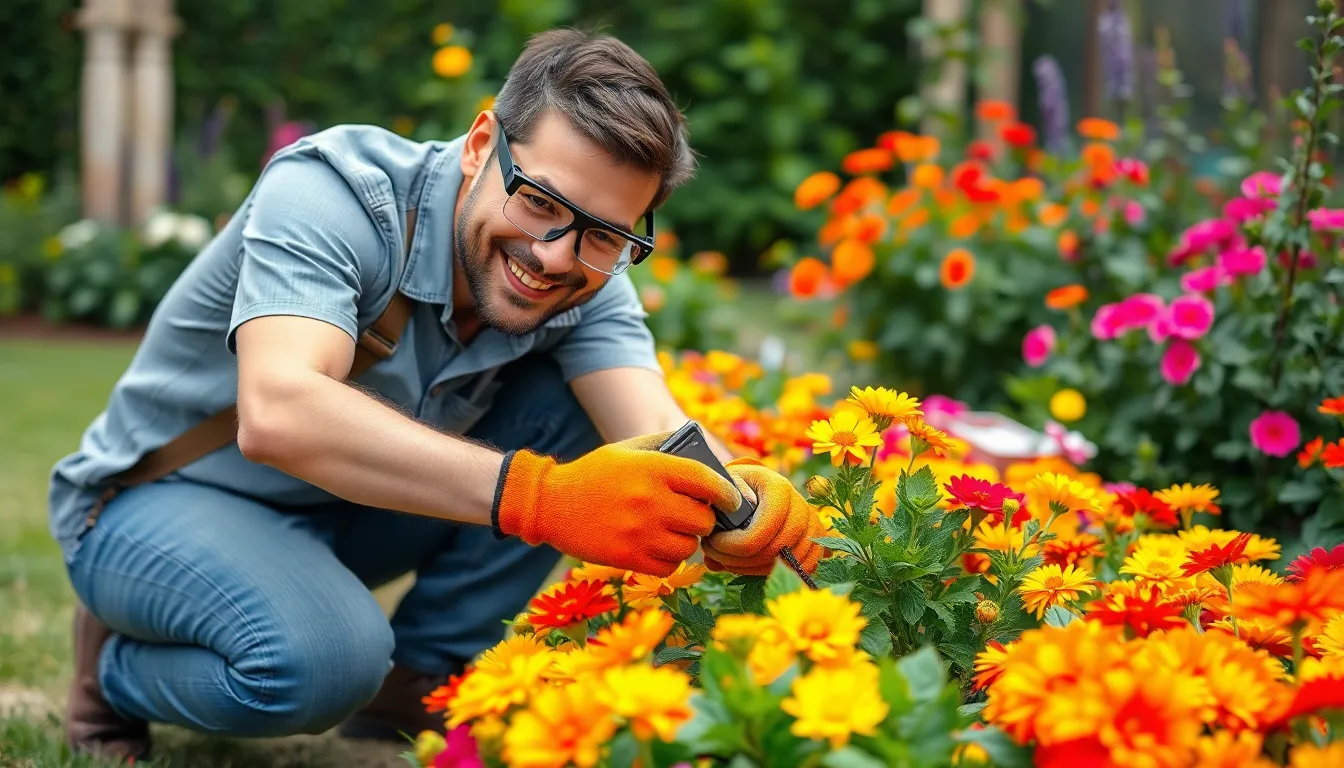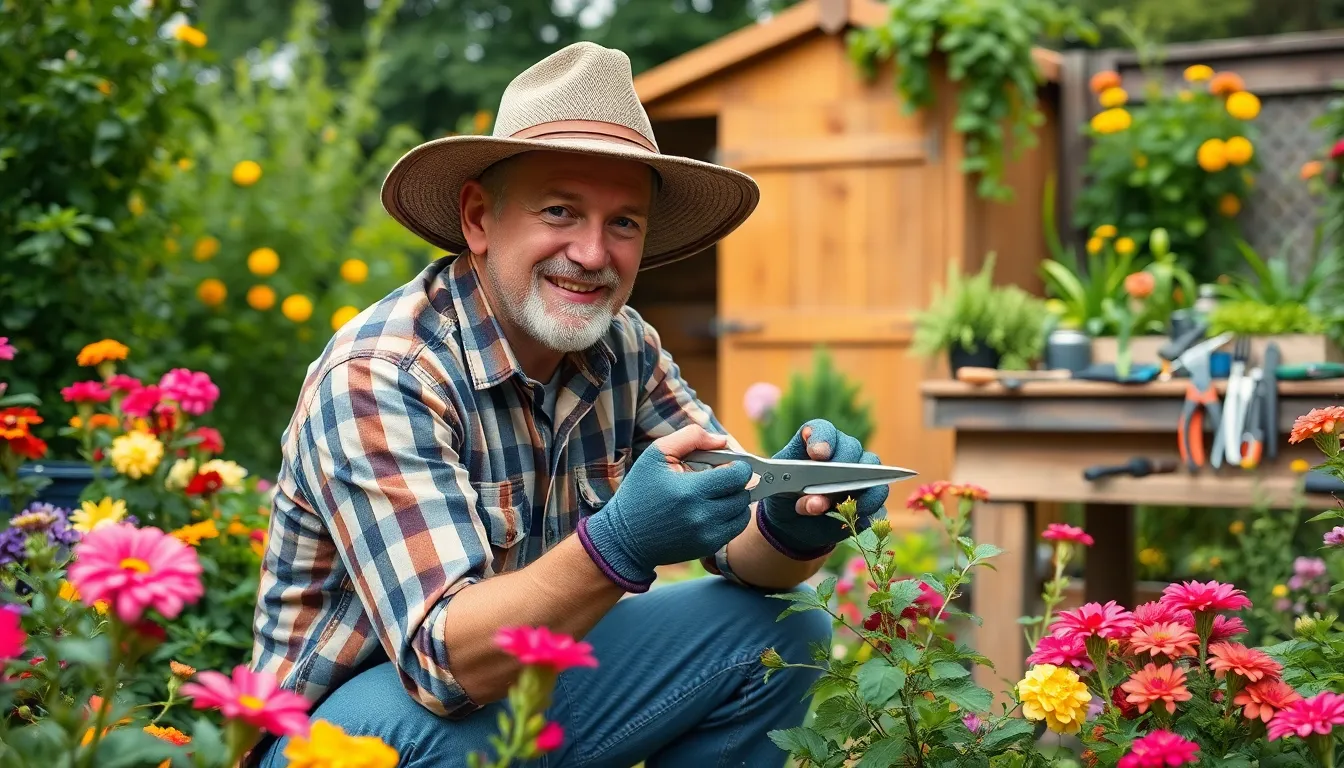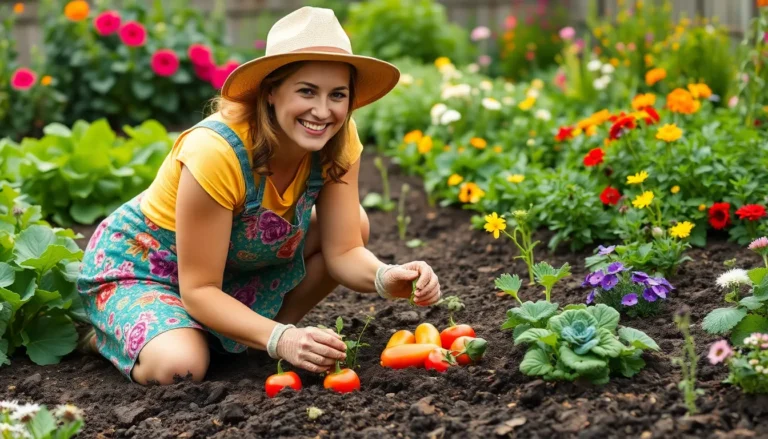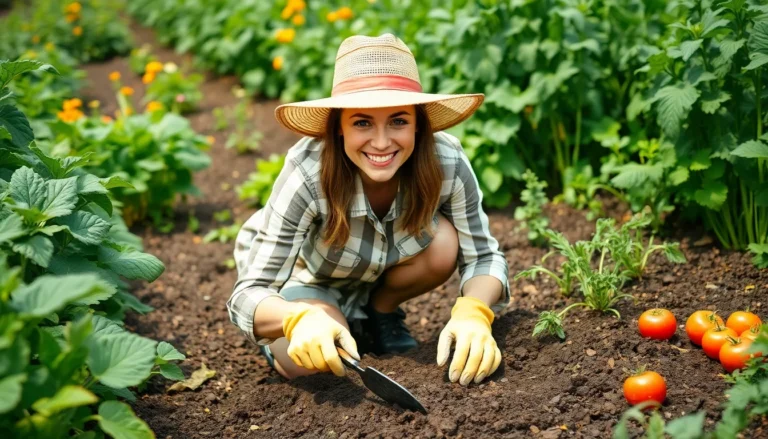Gardening can be a delightful escape into nature, but it’s not all sunshine and rainbows. With sharp tools, pesky pests, and the occasional rogue weed, it’s easy to find oneself in a bit of a pickle. Who knew that planting daisies could come with a side of danger? But fear not—safety doesn’t have to be boring.
Gardening Safety Tips
Gardening safety plays a crucial role in preventing accidents and injuries. Engaging in safe practices protects both the individual and the environment. Sharp tools, while essential, pose significant risks without proper handling.
Wearing appropriate protective gear minimizes exposure to harmful elements. Gloves prevent cuts from thorny plants, while sturdy footwear protects feet from sharp objects. Sun protection, including hats and sunscreen, minimizes the risk of sunburn and heat-related illnesses.
Understanding the hazards of pests contributes to safe gardening. Knowing how to identify harmful insects allows for timely intervention. Organic pest control methods reduce the need for toxic chemicals, ensuring a safer gardening experience.
Physical fitness forms another layer of safety. Stretching before gardening reduces the risk of strains and injuries. Lifting techniques, such as bending knees instead of the back, help prevent back injuries.
Proper tool maintenance enhances both safety and efficiency. Regularly inspecting tools for damage ensures reliability during use. Storing equipment properly prevents accidents when not in use.
Following local gardening guidelines also supports safety. Familiarity with specific regulations concerning chemical applications reduces risks to human health and wildlife. Consulting with local gardening experts provides additional insights into safe methods.
Maintaining a clean workspace improves visibility and reduces trip hazards. Clearing debris and organizing tools fosters a safer environment. Gardening safety isn’t just about accident prevention; it’s about fostering a sustainable experience that enhances well-being.
Essential Safety Gear

Safety gear plays a crucial role in gardening, minimizing risks while enhancing enjoyment in the garden. Proper equipment ensures protection against potential hazards.
Gloves
Gardening gloves provide essential protection for hands against sharp tools and abrasive surfaces. These gloves come in various materials, such as leather, rubber, and cotton, offering different levels of durability. Selection of gloves should consider the specific tasks involved. For instance, heavy-duty gloves work well for pruning thorny plants, while lighter options suit delicate weeding tasks. Gloves also prevent skin irritation from chemicals and allergens often found in soil and plants.
Eye Protection
Protective eyewear is vital in gardening, especially during tasks like trimming and mowing. Flying debris, such as small stones and plant fragments, poses a risk to the eyes. Selecting safety glasses with side shields offers comprehensive protection from potential hazards. Chemical splashes can also occur during pesticide application; using goggles can prevent serious injuries. Prioritizing eye protection encourages safe gardening practices and focuses on long-term health.
Sturdy Footwear
Sturdy footwear ensures safety while navigating uneven terrain in a garden. Shoes with slip-resistant soles minimize the risk of slipping, especially in wet conditions. Additionally, closed-toe shoes protect feet from sharp tools and fallen debris. Waterproof options are advantageous when working in damp soil or after rainfall. Prioritizing footwear comfort and support can also prevent fatigue during long gardening sessions.
Safe Tool Usage
Safe tool usage in gardening is essential for preventing accidents and injuries. Understanding how to maintain and handle tools properly enhances safety and efficiency in the garden.
Maintenance of Tools
Regular maintenance of gardening tools ensures their longevity and effectiveness. Cleaning tools after each use prevents the spread of diseases between plants. Sharpening blades minimizes the effort needed for cutting and reduces the risk of slipping. Inspecting tools for damage allows for early repairs, which keeps users safe. Oil metallic surfaces to prevent rust, which can compromise both the tool’s functionality and user safety.
Correct Handling Techniques
Correct handling techniques enhance safety and efficiency in gardening tasks. Always carry tools with pointed ends facing down, which minimizes the risk of accidental injury. When using sharp instruments like pruners or shears, maintain focus on the task to avoid unintentional cuts. Store tools in designated areas after use, keeping them out of reach of children and pets. Using two hands for heavier tools ensures better control, reducing the chance of dropping them.
Environmental Considerations
Gardening involves awareness of environmental factors. Weather conditions significantly impact gardening activities and safety.
Weather Conditions
Severe weather poses risks during gardening tasks. Rain can create slippery surfaces, increasing the chances of falls. Extreme heat can lead to heat exhaustion or dehydration. Gardeners must stay hydrated and take breaks in shaded areas. Cold temperatures elevate the risk of frostbite, so wearing appropriate clothing helps. Monitoring forecasts allows for planned gardening schedules, reducing exposure to hazardous weather events. Planning for inclement weather ensures not only safety but also a productive gardening experience.
Pest Management
Pest management is crucial for maintaining a healthy garden. Familiarity with local pest populations helps gardeners choose effective control methods. Integrated pest management (IPM) emphasizes environmental health by combining biological, cultural, and mechanical strategies. Choosing organic solutions minimizes chemical exposure while being effective. Regularly inspecting plants contributes to early detection of infestations. Implementing companion planting attracts beneficial insects known for pest control. Maintaining garden hygiene by clearing debris prevents pest habitats. These proactive practices enhance safety and support a thriving garden ecosystem.
First Aid Preparedness
Gardening can lead to injuries, making first aid preparedness essential. Having the right supplies on hand minimizes the impact of incidents.
Basic First Aid Kit
A basic first aid kit should include essential items like adhesive bandages, antiseptic wipes, and gauze pads. Tweezers assist with splinter removal while scissors can cut bandages or tape. Incorporating gloves promotes hygiene, and a cold pack helps reduce swelling from injuries. Pain relief medication like ibuprofen or acetaminophen can also be useful. Regularly checking the kit ensures all supplies remain stocked and functioning, allowing for quick responses during emergencies.
Common Gardening Injuries
Common injuries in gardening involve cuts, scrapes, and insect bites. Cuts often occur when handling sharp tools, emphasizing the need for gloves. Scrapes may happen while navigating overgrown areas or during falls, so it’s crucial to clean wounds promptly. Additionally, insect bites and stings from pests like bees or mosquitoes can lead to allergic reactions. Being aware of these risks allows gardeners to take preventive measures, ensuring a safer gardening experience.
Conclusion
Gardening can be a fulfilling and enjoyable activity when safety is prioritized. By adopting the right practices and using proper gear gardeners can significantly reduce risks associated with tools pests and weather. Staying informed about potential hazards and preparing for emergencies ensures a safer experience in the garden.
Creating a clean and organized workspace not only enhances safety but also contributes to a more enjoyable gardening session. Embracing safety measures allows gardeners to focus on the joy of nurturing plants while protecting themselves and the environment. With these tips in mind anyone can cultivate a thriving garden with confidence.





